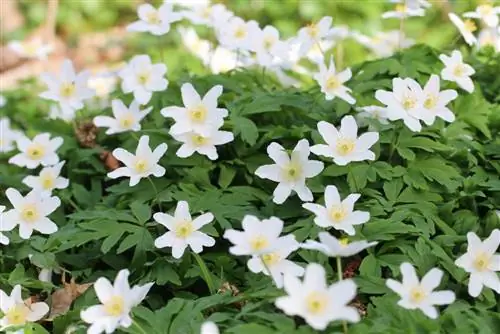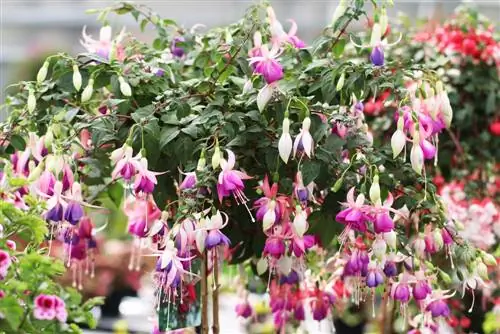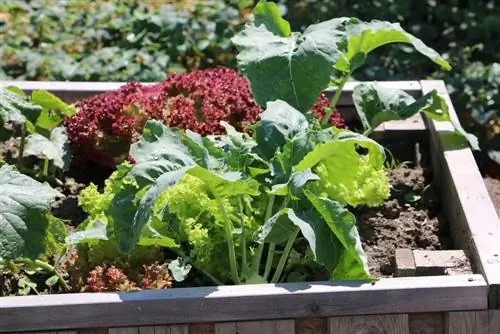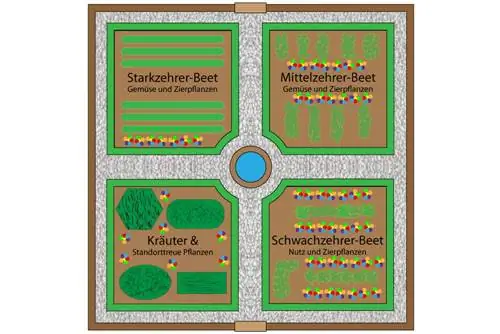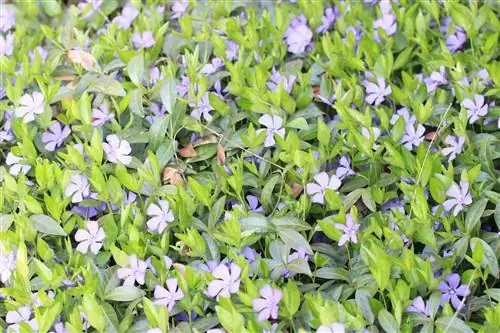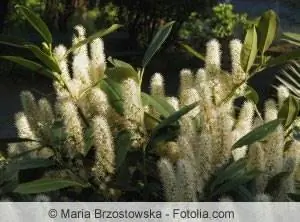- Author admin [email protected].
- Public 2023-12-17 03:39.
- Last modified 2025-06-01 06:48.
The German gardener can choose from a total of around 40,000 ornamental plants, and flowering perennials make up a significant proportion of these ornamental plants. It is not without reason that perennial, non-woody perennials represent the second large group of “self-starters” in our gardens alongside the woody plants. The flowering perennials are among the most grateful flowering plants ever, with more long-flowering than short-flowering perennials, there are almost endless possibilities for creating a planting plan for a flowering perennial bed:
The flowering perennials
Right at the beginning, for motivation, a small list of flowering perennials, with flowering times throughout the year:
The first flowers from March
- Anemone nemorosa, Anemone
- Alyssum montanum, mountain stonewort
- C altha palustris, marsh marigold
- Epimedium perralderianum, elf flower
- Omphalodes verna, spring umbilical nut
- Primula elatior, key to heaven, delicate yellow flowers
- Pulmonaria angustifolia, narrow-leaved lungwort, variety 'Azurea' with royal blue flowers
- Pulmonaria rubra, garden lungwort, bright red flowers
- Pulsatilla vulgaris, pasqueflower, light purple flowers
The spring bloomers from April
- Ajuga reptans, Creeping Gunsel
- Alyssum saxatile, rock alyssum, yellow flower
- Aquilegia hybrid, columbine, variety 'Blue Tones' flowers intense blue
- Aubrieta hybrids, blue cushions in varieties, 'Neusel' lavender blue, 'Royal Blue' dark blue, 'Royal Red' magenta, 'Dr. Mules' dark purple
- Bergenia cordifolia, Bergenia
- Brunnera macrophylla, large-leaved Caucasian forget-me-not, pure blue flowers
- Buglossoides purpurocaerulea, blue-red stone seed, royal blue flowers
- Corydalis lutea, yellow larkspur
- Dicentra spectabilis, bleeding heart, pink to crimson flowers
- Geranium macrorrhizum, Balkan cranesbill
- Gypsophila Repens
- Helianthemum hybrid, sunflower
- Heuchera hybrid, purple bells, 'firefly' flowers dark scarlet red, 'Red Spangles' bright red
- Lychnis viscaria, common pitch carnation, variety 'Plena' blooms bright pink
- Phlox subulata, cushion phlox
- Polemonium caeruleum, blue ladder to heaven, blue flowers
- Pulmonaria rubra, garden lungwort, variety 'Dora Bielefeld' blooms bright pink
- Vinca minor + major, small + large periwinkle
- Waldsteinia geoides, lobed-leaved Waldsteinia, yellow flowers
- Paeonia officinalis, peony
- Saxifraga urbium, porcelain flower, variety 'Clarence Elliott' flowers pink
- Tellima grandiflora, false mandrake root, flowers greenish pink and like a giant lily of the valley
- Veronica austriaca teucrium, tufted speedwell
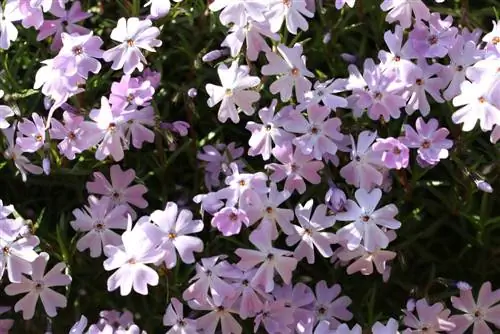
Perennial summer blossoms
- Aconitum napellus, monkshood, dark blue flower
- Achillea Millefolium Hybrid
- Aquilegia alpina, columbine in pure blue
- Delphinium grandiflorum, e.g. B. in the variety 'Blue Dwarf' bright with bright light blue flowers
- Dianthus deltoides, heather carnation
- Digitalis purpurea, flowers pink, carmine, purple
- Hemerocallis hybrid, daylily
- Hosta crispula, hosta, flowers light purple
- Linum perenne, perennial flax
- Lupinus Polyphyllus, Many-leaved Lupine
- Oenothera tetragona, garden evening primrose
- Papaver orientale, e.g. B. in variety 'Queen Alexandra' salmon pink
- Rodgersia, display leaf, creamy white to wine-red flower clusters
- Sedum acre, stonecrop, bright yellow flowers
- Trollius chinensis, garden trollflower
Autumn to Winter
- Aconitum carmichaelii, autumn monkshood, deep purple flowers
- Ceratostigma plumbaginoides, Chinese Plumbago
- Coreopsis grandiflora, girl's eye, golden yellow flowers
- Cortaderia selloana 'Pink Feather', pampas grass with pink fronds
- Filipendula ulmaria, meadowsweet, creamy white flowers
- Geranium endressii, Basque cranesbill, pink flower
- Helleborus niger, Christmas rose
- Miscanthus sinensis, miscanthus, silvery to light red flowers
- Oenothera missouriensis, Missouri evening primrose, light to lemon yellow flowers
- Phuopsis stylosa, long-handled rose woodruff, pink flowers
- Sedum telephium, large stonecrop
- Solidago caesia, golden ribbon rod, golden yellow flowers
All flower colors, all flower heights, and these include the classic flowering perennials such as aster, iris (iris, perennial of the year 2016), chrysanthemum and the classic natural garden beauties such as spurge, wild strawberry, woodruff and the perennial grasses (Carex, sedges, perennial of the year 2015) not included yet.
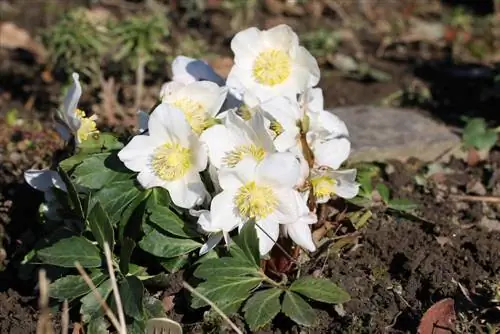
There are cultivars of every type of perennial, sometimes an incredible number, with different colors and different flowering times, and some of the spring bloomers bloom all summer anyway - it's not difficult to create a bed with flowering perennials that lasts the whole blooms throughout the season. Especially when such a variety of flowering plants are available, the design should not be haphazard:
The flowering perennial bed
Now you've indulged enough in flowering perennials, one or two wonderfully colorful beds have probably already passed through your mind's eye. Now it's time to develop a basic idea for your perennial bed, the following thoughts could or should play a role:
- The bed full of flowering perennials will probably be the most eye-catching part of your “decorative garden”
- A fairly maintenance-intensive part, which is why the size of the bed should be carefully considered
- The more in the immediate field of vision, the more care it needs to keep the bed looking neat
- In addition to the location and size, the basic shape of the bed(s) must be decided
- It makes a big difference when choosing plants whether you want to plant a larger bed or several small spots
- If the location is more important to you than the shape, the specifications usually result from the previous garden design
- Also with regard to the later harmonious effect, dead-straight paths tend not to be compatible with a bed in a curved fantasy shape
- And vice versa, square beds in front of beautifully curved paths through the garden can look just as strange
- The more precisely your garden is structured, the more precisely the bed outlines must be planned
- Perhaps with a little space for a designed bed border
- In the natural garden, which is deliberately designed to be “messy”, splashes of color can be distributed casually
Some ideas
The colorful variety of perennials can quickly overwhelm the gardener, a motto makes the selection easier and gives the flowering perennial bed structure:
Blooming perennial bed with lots of color
The entire spectrum of colors and flowers can be combined with the perennials, in graduated harmonies or contrasts:
- Tone on tone, e.g. B. only perennials that bloom in as similar red as possible or only pink, purple, yellow blooming perennials
- Tone on tone, but from light to dark, e.g. B. from pink to strong pink, e.g. E.g. soft pink columbines, full pink ranunculus, pink hollyhocks
- You can combine related colors, turquoise and blue, ultramarine blue and violet
- You can plant a range of neighboring colors, yellow, golden yellow, orange and orange-red
- You can plant perennials in complementary colors, blue and orange for example
- Or you can simply plant all your favorite colors in the bed, red, orange and violet for example
Extravagant: flowering perennial with colorful leaf decorations
An unusual variant of the flowering perennial bed combines leafy perennials with harmonizing flowers:
- The Heuchera hybrid “Berry Smoothie” blooms bright pink, with delicate blue chicory a spherical fairytale world
- The purple Huhnera hybrid “Plum Pudding” creates an equally dreamy combination with dull pink mallows and purple peonies
- Simple hostas with white variegated and strong yellow variegated leaves offer a quite surprising picture when combined with daisies
- Silverleaf sage under soft pink sedum cushions creates a bed as fluffy as a cozy sofa
- Cream-colored Turkish lilies between delicate miscanthus fronds is elegance tone on tone
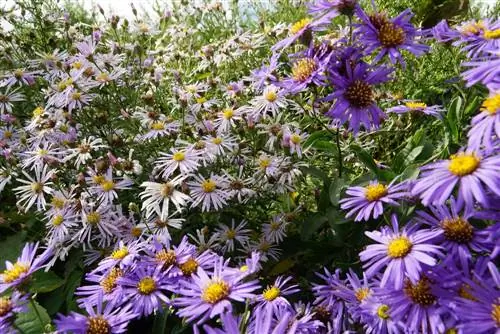
Flowering perennials by type/variety
Always interesting for purists, and the wildest color combinations are possible here:
- Asters in pink, hot pink, magenta, light blue, light purple, violet can paint pictures in beds
- Chrysanthemums in all shades of orange and red are more reminiscent of “fire in the bed”
- Entire beds full of colors of the same variety can be created with many flowering perennials
- You can combine flowering perennials of different varieties and heights
- From “small and red” to “big and red” or as a swing through the entire color palette
- Purists like white on white, in as many varieties as possible
Flowering perennials “in shape”
Not the shape of the flowers, but the shape of the perennials in the bed, you can use them to plant patterns:
- An island of tall flowering perennials is surrounded by smaller flowering perennials
- Or several islands intertwine in a bed
- Such an island does not have to be round, it can also be oval, teardrop-shaped, square
- So a diced bed is possible, or a striped one, or one full of diamonds
- You can also paint a picture or a symbol in your bed
Flowering perennial with leafy greens
If all this is too colorful for you, it's easy: combine a flowering perennial with a matching evergreen plant. Ivy and fat man with small flowering shrubs, evergreen creeping spindle with golden yellow chrysanthemums, all sorts of tall grasses with all sorts of flowering shrubs of approximately the same height
Create instructions for the planting plan - what is important?
Without proper planning, none of these ideas will see the light of day the way you already see them in your head. Rather, the planting plan is put together according to certain specifications that gardeners have developed over many years of experience:
1. Select leading plants, the most expressive and tallest growing plants that should dominate the bed.
These are large, magnificent perennials that immediately catch the eye. They get the best spots in the bed, the rest is planted around them and depends on them. Examples of these perennials, also known as scaffolding plants:
- Flame Flowers
- Lilies
- Peonies
- Magnificent Sparrows
- Rocket Flowers
- Darkpur,
- Silver Candles
- Turkish Poppy
- Steppe candles
You shouldn't use too many of these key plants, as this weakens their effect rather than providing visual benefit.
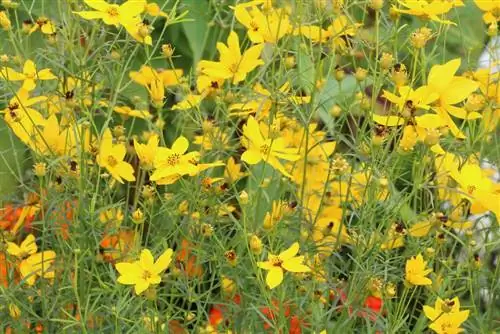
2. Select suitable (or contrasting) companion plants that give the basic shape to the planned geometry of the bed.
They are planted in groups around the leader plants and are slightly smaller and somewhat more inconspicuous than the leader plants. All colorfully flowering, low and medium-tall perennials can become companion plants. The selection must be large so that the companion plants can be chosen in a matching color. Examples of companion plants:
- Akelein
- Asters
- Monkshoods
- Foxgloves
- Geraniums
- girl eyes
- Carnations
- Coneflower
- Daylilies
- bleeding heart
3. The remaining free areas are covered with so-called filler plants, ground cover or carpet-forming flowering perennials.
4. Lead plants, companion plants and filler plants are staggered according to flowering time so that the perennial bed blooms without a break from spring to autumn.
5. If you intend to design a bed using patterns or pictures, you will, contrary to tradition, select equivalent flowering perennials that should bloom together for as long as possible.
Now you just have to check whether your planting plan is feasible in the planned location. The location must be suitable for the planned planting without you having to invest more work than a little soil maintenance. If necessary, it's better to replan again, as you can't change the lighting conditions anyway, then you can start buying plants.
Note:
There is not one set of instructions for creating a planting plan for a flowering perennial bed, but rather many different ones. Starting from a certain basic idea, you can combine flowering perennials with any design you would like to see in your garden.

